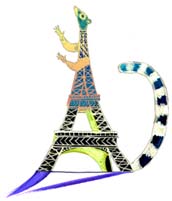Many human inventions don’t look so extraordinary when compared to their counterparts in nature. Often, nature has solved the same problem in a more efficient, less wasteful and more sustainable manner. It’s no surprise, then, that science and industry are increasingly turning to natural designs and processes for inspiration. Biomimicry, defined as "innovation inspired by nature," is responsible for some of the most familiar and cutting-edge breakthroughs in technology. Janine Benyus, author of Biomimicry, illustrated this approach at Wharton’s Second Annual Emerging Technologies Update Day on Friday, Feb. 11. "Nature is a master technologist," declared Benyus. "Animals are ahead of us in the technology race. Yet with the exception of the genetic and molecular world, we in Western industrialized culture in the last 100 years haven’t done a good job of looking at nature. We tend to believe that human technology is somehow different." "What do you see when you look at compound eyes?" she challenged. "At butterfly wings? Dolphins? Bats? Swans?" Where most people merely see eyes or wings, designers see possibilities. Velcro was modeled on burdock burrs; drag reducers were made to resemble the denticles of sharkskin. Architects have used natural inspiration as well; the Eiffel Tower was modeled on the head of a femur, and the Sydney Opera House on milkweed pods. The scales of butterflies – hot creatures which need to thermoregulate – were the inspiration for chip coolants. Submarine exteriors took their cue from the slimy skin of dolphins, to reduce their telltale "signature" by decreasing turbulence. Radar, of course, was modeled on the sonar of bats and dolphins. In the past, biomimicry was used primarily in defense and aerospace research. "You can see why the military would invest in this," said Benyus. "They’re all about blending in, miniaturizing, being multifunctional and maneuvering without a lot of fuel." Organisms which must live with limited resources were the perfect models for such situations. Benyus suggested that the time had come for other businesses to think along the same lines. "This is what industry needs now. There’s a lot of talk about sustainability and green manufacturing," she said. "Certainly I would say that our technologies and artifacts are natural; they are extensions of us. But are they well adapted to live on earth? We have 70,000 synthesized chemicals. Only 6% of material ends up as product; 94% goes to waste. Half of all U.S. ecosystems are degraded." Other creatures, Benyus said, could help provide solutions. "There are 30 million to 100 million species that have worked this out. We’re beginning to ask them some questions." In the area of materials science, said Benyus, the usual method is to "heat, beat and treat." "Normally we take a bulk material and carve it down to what we want," she said. "That’s the opposite of what nature does. Take Kevlar. We take a petroleum product, heat it up and draw it out under pressure to make a fiber. It’s strong and tough but it ends up in landfills." Spiders, said Benyus, have a better production process. A spider has to manufacture similarly tough fibers. "But instead of a top-down process, nature templates at the DNA level exactly what it wants," she said. "All the energy is put in at the cellular level. Liquid protein in the spider abdomen is squeezed out through spinnerets. The protein self-assembles; the process is silent. Ounce for ounce, dragline silk is five times stronger than steel." According to Benyus, biomimicry is especially useful for designing agricultural systems, "Our system of agriculture is largely one of annual monoculture; we plant one species for miles. However, this ends up being an all-you-can-eat pest restaurant." Scientists, she said, conducted an experiment to answer the question, "What would nature do?" A natural tall grass prairie was cut down, and everything in it was dried, weighed and sorted into piles. "It turned out to be a polyculture," noted Benyus. "It was 99% perennial, with a combination of cool-season grasses, warm-season grasses, nitrogen fixers and composites. Perhaps the key to more sustainable agriculture is to breed perennialism back in, harvest at different times of year, and plant different species in the same field." Benyus noted that biomimicry was fast becoming a necessity. "At one time," she said, "we were a small population in a resource-laden world. We could afford to be consumptive, linear and temporary. However, habitat conditions have changed. We are now a full population in a world empty of resources. What kind of systems need to develop? Those that are nonconsumptive, cyclical and self-sustaining." True sustainability, she noted, even in the business world, is all about creating conditions conducive to life.
Looking for more insights?
Sign up to stay informed about our latest article releases.



